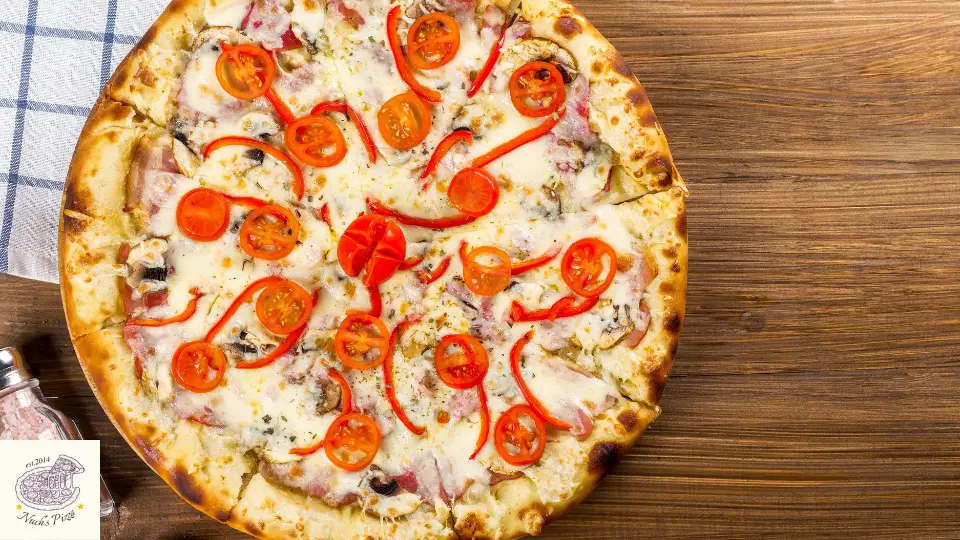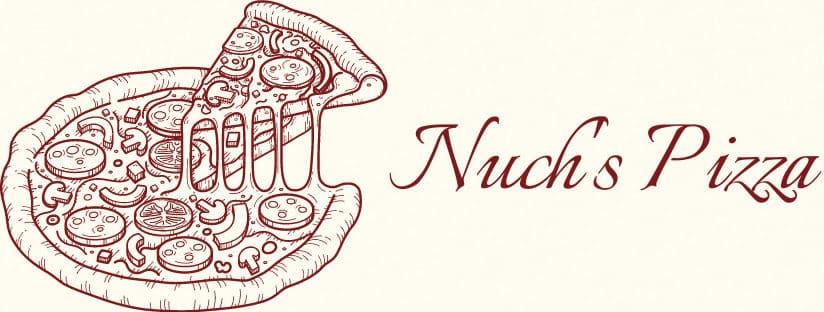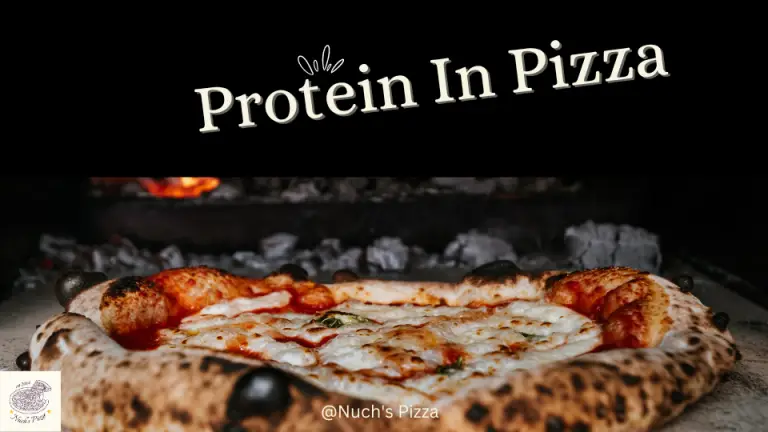Welcome to the wonderful world of pizza! We’re here to answer all your questions about protein in pizza. With more and more people becoming aware of the nutritional benefits of adding protein to their diet, it’s no wonder we are taking a closer look at one of everyone’s favorite meals – pizza. Let us explore the tasty ways you can get your daily dose of protein without compromising on flavor!
How Much Protein In Pizza?

Regarding pizza, the amount of protein varies depending on the type and toppings you choose. A plain cheese pizza typically contains around 7-12 grams of protein 1, while a typical pepperoni slice can contain upwards of 15-20 grams. Different types of crust also affect how much protein is in a single piece. For example, a thin crust can provide as little as 5 grams of protein per slice, while a medium crust slice can contain 8-15 grams.
Vegetables, such as mushrooms, bell peppers, and onions, are delicious and excellent protein sources. When you add these nutritious toppings to your pizza, you can expect an additional 3-5 grams of protein per topping. On the other hand, if you prefer meat toppings like sausage, pepperoni, or bacon, you’ll be delighted to know that each slice can provide you with a whopping 15-20 grams of protein. So, whether you’re a vegetarian or a meat lover, pizza can be a satisfying and protein-packed meal option!
What Are The Components Contributing Protein In Pizza?

Many components of pizza contribute to its protein content.
Types Of Dough
The type of dough you choose can make a big difference in the protein content of your pizza. For example, whole wheat crust has more protein than white flour dough. Also, some brands offer options such as quinoa and oat-based doughs which are higher in protein than other types of dough.
Cheese
Cheese plays a significant role in providing protein to pizza. The protein content per slice varies based on the type of cheese, ranging from 4-8 grams. For instance, with its creamy texture and mild flavor, mozzarella contains approximately 6 grams of protein per ounce 2.
On the other hand, Parmesan, known for its distinct sharpness and nutty taste, boasts an impressive 8 grams of protein per ounce. So, whether you prefer the gooey goodness of mozzarella or the boldness of Parmesan, you can enjoy a delicious slice of pizza packed with protein!
Toppings
Adding toppings to your pizza is a delicious way to enhance its flavor and a clever strategy to increase its protein content. Whether you’re a vegetarian or a meat lover, plenty of options exist. For vegetarians, toppings like mushrooms, artichokes, and olives add a burst of flavor and contribute a good amount of protein. They provide approximately 2-3 grams of protein per topping.
Meat toppings such as beef, chicken, and pepperoni provide an extra protein boost. Each option contains around 9-10 grams of protein per topping. So, regardless of your dietary preferences, you can customize your pizza to your heart’s content, ensuring that it satisfies your taste buds and meets your protein needs.
Sauce
The sauce you choose can also make a difference in the nutritional value of your pizza. Marinara sauce is an excellent option, providing 1-2 grams of protein per serving and adding a classic Italian flavor to your pizza. Additionally, some sauces are made with protein-rich ingredients like lentils or beans. For instance, black bean-based sauces contain around 4 grams of protein per serving.
Portion Size
The size of your slice of pizza plays a significant role in determining the amount of protein you consume. When you opt for a large slice, it naturally contains more protein than a smaller one. Generally, one large slice of pizza provides approximately 15-20 grams of protein, giving you a satisfying and protein-rich meal.
However, suppose you’re conscious of your calorie intake and prefer a lighter option. In that case, you can choose a smaller slice that still packs around 8-10 grams of protein, ensuring you get a decent protein boost while managing your overall calorie consumption. So, whether you’re craving a hearty meal or aiming for a more balanced indulgence, adjusting your slice size can help you customize your protein intake accordingly.
What Are The Benefit Of Protein To Our Body?
Protein is an essential macronutrient in our diets that helps to keep us feeling energized and nourished. It also contributes to a range of physiological functions, such as maintaining the structure of cells, tissues, muscles, and organs; helping to control fluid balance in the body; aiding with enzymatic reactions in metabolism; providing energy for physical activity; and regulating our hormones.
Moreover, protein is essential for building muscle strength and size, which in turn helps to boost athletic performance. It’s also essential for repairing muscles after exercise and helping recover from injury or illness. A diet rich in protein can help manage weight by promoting satiety (a feeling of fullness) and aiding the body in burning fat.
So, while pizza isn’t usually associated with protein-rich foods, it provides a good source of this essential macronutrient. Therefore, if you’re seeking an indulgence that won’t compromise your health goals, pizza is a great option! With its high protein content per slice and delicious flavor, pizza is an excellent alternative to traditional protein sources such as eggs, fish, and meat. Plus, if you’re looking for a
Is Protein From Pizza Brands Different?
Yes, different pizza brands use other ingredients in their recipes, such as the type of flour, cheese and toppings used. This will affect the nutritional content of each slice, including its protein levels. For instance, some pizzas may have higher amounts of whole-grain flour or more cheese to boost their protein content.
Costco Pizza
Costco pizza is a popular choice for many families. The brand uses high-quality ingredients, and their pizzas are made with a high-protein dough to help deliver double the protein compared to other traditional pizzas. Additionally, Costco adds extra layers of cheese for an even higher protein content. This makes it an excellent choice if you’re looking for a pizza that’s both
In detail, Costco uses a 50/50 blend of whole grain and high-protein wheat flour, which provides 12g of protein per serving. The mozzarella cheese and other toppings add 10g of protein to each slice, giving it 22g protein in every two slices. So if you’re looking for an indulgent pizza with a good source of protein, Costco pizza is a great option!
Pizza Hut
Pizza Hut’s recipes also include some high-protein ingredients. The brand employs a multigrain flour blend for their dough, which includes whole wheat, rye, and oats to boost protein. Furthermore, the brand adds a generous layer of cheese to each pizza for even more nutrition. This helps make Pizza Hut’s pizzas a great source of both flavor and protein.
Pizza Hut’s pizzas have about 12g of protein per two slices. However, the actual numbers may vary depending on your pizza type. For instance, a double cheese pizza will have more protein as it has an extra layer of cheese compared to other options.
Little Caesars
Little Caesars also offers a good source of protein with its pizzas. The brand uses whole wheat flour and lots of cheese to provide substantial protein per two slices. Additionally, Little Caesars adds a bit of extra sauce to their pizzas, which helps bring out the flavor even more. Each slice has roughly 12g of protein, and with two slices, that adds up to 24g.
When it comes to protein-packed pizza, Little Caesars is a great choice. With its high-protein ingredients and delicious flavor, you won’t be disappointed!
Domino’s Pizza
Domino’s Pizza also provides a good source of protein for those who enjoy a slice. The brand’s classic recipe adds whole wheat flour to their pizzas and uses lots of cheese for more nutrition. Additionally, Domino’s Pizza uses extra tomato sauce for added flavor, which helps boost the protein content.
Domino’s Pizza provides roughly 12g of protein per two slices. However, the number may vary depending on your pizza type. For example, certain specialty pizzas, such as BBQ chicken pizza, will have more protein due to their unique ingredients.
Papa John’s
Last but certainly not least, Papa John’s offers a good source of protein in their pizza creations. The brand uses a combination of whole wheat flour and quality cheese to provide the protein. Papa John’s adds extra sauce for more flavor without sacrificing nutrition.
Each two slices of Papa John’s Pizza will contain roughly 11g of protein. This number may vary depending on which type of pizza you choose, but overall Papa John’s is an excellent choice for a protein-packed pizza.
Little Caesars, Domino’s Pizza, and Papa John’s are great options if you’re looking for a delicious way to get your protein fix. These pizzas won’t disappoint you with their high-protein ingredients and delicious flavors!
How To Have A Balance Nutrients Pizza?
Having a balanced meal is essential for keeping your body healthy and energized. Fortunately, getting protein from pizza doesn’t mean you have to skip out on other important nutrients. To ensure you get all the vitamins and minerals your body needs, pair your pizza with vegetables or a salad to ensure you’re getting a well-rounded meal.
If you’d like to boost the protein content further, consider adding grilled chicken or lean beef to your pizza. Not only will this add more protein to your meal, but it will also make it even tastier! They contain essential amino acids necessary for the body’s growth and repair.
Additionally, choosing a thin-crust pizza is a great way to reduce the amount of calories and fat in your meal. For example, a thin-crust cheese pizza will have about 40 fewer calories per slice than a regular crust version.
FAQs
How Much Protein Should You Get in a Pizza?
The amount of protein you should get in pizza depends mainly on the type and size of the pizza. For example, two slices of Papa John’s cheese pizza contain about 11g of protein. However, adding additional toppings, such as grilled chicken or beef, will increase your protein intake even more.
Does Thin Crust Pizza Have Higher Protein?
No, thin-crust pizza does not necessarily have higher protein. However, you will get fewer calories per serving with a thin-crust pizza than if you choose a regular-crust version. This is because the thinner dough contains less flour and thus has a lower calorie count.
What Are Some Healthy Toppings for Pizza?
Some healthy toppings for pizza include lean proteins such as grilled chicken, lean beef, or shrimp. Additionally, adding vegetables like spinach, bell peppers, and mushrooms can increase your veggie intake while keeping the calories low. Lastly, sprinkling some nuts, such as pine nuts or cashews, on top can add more protein to your meal.
What Is Type Of Sauce Having High Protein Content?
A type of sauce that has a high protein content is pesto sauce. This flavorful Italian sauce usually contains pine nuts, olive oil, Parmesan cheese and basil. Pesto sauce can add much flavor to your pizza without the extra calories. Plus, you’ll get about 2g of protein per tablespoon!
Does Pepperoni Pizza Have High Protein?
Yes, pepperoni pizza does have a high protein content. Most two slices of this type of pizza will contain about 18g of protein. This is due to the combination of cheese and pepperoni, which are packed with protein.
Conclusion
Protein in pizza is possible! Pizza can be a great source of protein and nutrition and a tasty treat. Pizza is a trendy food, and a huge variety of toppings can add texture, flavor, and nutrition to any pizza. Protein-packed toppings like pepperoni, bacon, ham, sausage, and Canadian bacon can increase the protein content of your favorite slice and make it sinful yet delicious! Remember not to overdo it on the toppings, though, as too many high-fat ingredients can also decrease from the nutritional value.

Iris Harper is a professional writer and restaurant set up consultant. She has over 10 years of experience in the food industry, and loves providing her clients with top-quality service. Her food reviews are highly sought after, as she has a knack for discovering new and delicious pizza creations.






